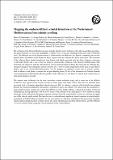Por favor, use este identificador para citar o enlazar a este item:
http://hdl.handle.net/10261/132722COMPARTIR / EXPORTAR:
 SHARE
BASE SHARE
BASE
|
|
| Visualizar otros formatos: MARC | Dublin Core | RDF | ORE | MODS | METS | DIDL | DATACITE | |

| Título: | Mapping the onshore/offshore crustal transition at the Westernmost Mediterranean from seismic profiling |
Autor: | Cembrowski, Marcel; Gallart Muset, Josep CSIC ORCID; Schimmel, Martin CSIC ORCID ; Diaz, J. CSIC ORCID ; Carbonell, Ramón CSIC ORCID ; Gràcia, Eulàlia CSIC ORCID ; Ranero, César R. CSIC ORCID; Palomeras, Imma | Fecha de publicación: | 9-abr-2013 | Editor: | European Geosciences Union | Citación: | Geophysical Research Abstracts 15: EGU2013-8209 (2013) | Resumen: | The evolution of theWesternMediterranean is strongly affected by the collision of the African and Eurasian plates. The plate boundary as seen from earthquakes is diffuse over a wide area extending north and south of Gibraltar strait. The Western end of the Mediterranean is delineated by the Gibraltar Arc System, comprising the arcuate Spanish Betic and Moroccan Rif Mountain Belts, together with the Alboran-Sea Basin in-between. The extension of the Alboran Basin which started from Late Eocene and which coexisted with the Africa -Europe conversion is still under debate and is one of the key points to constrain the evolution of the Western Mediterranean. This motivated our interest to map the still unknown crustal transition from the Betic-Rif chain into the Alboran Sea, taking advantage of the coincidence in time (October 2011) of two seismic experiments in the area, on land (Rifsis project) and at sea (Gassis-WestMed project). For this purpose we deployed several tens of seismic stations, both in Morocco and Spain, to record the air-gun shooting (every 50 m) of the Sarmiento de Gamboa Spanish vessel performing multichannel reflection profiles at the Alboran sea, and hence to extend these marine lines to wide-angle distances in-land. The airguns were calibrated for the near zero-offset marine reflection study and it turns out to be difficult to observe clear signals on the records in-land at offsets larger than about 70 km. The data has therefore been processed with a frequency-dependent lateral coherence filter to enhance coherent reflection/refraction signals through the frequency-dependent attenuation of incoherent noise and signals. This processing has permitted to track signals (seismic energy) up to more than 200 km on some profiles. Hence, a classical procedure of forward modeling (ray tracing approach) to fit the travel times of the identified wide-angle phases is now underway, taking advantage of the sedimentary/basement sequences inferred from the multichannel sections to constrain the upper part of the velocity-depth model. The first structural results delineate significant lateral variations in crustal depths, particularly at the Rif-Alboran transition. In our presentation we will show and discuss data processing examples which enabled signal detection to large offsets, the signal identification and their interpretation, and the different 2-D cross sections which image the crustal transition to the Alboran Basin | Descripción: | Cembrowski, Marcel... et. al.-- European Geosciences Union General Assembly 2013, 7-12 April, Vienna, Austria.-- 1 page | Versión del editor: | http://meetingorganizer.copernicus.org/EGU2013/posters/12112 | URI: | http://hdl.handle.net/10261/132722 | E-ISSN: | 1607-7962 |
| Aparece en las colecciones: | (ICM) Comunicaciones congresos (Geo3Bcn) Comunicaciones congresos |
Ficheros en este ítem:
| Fichero | Descripción | Tamaño | Formato | |
|---|---|---|---|---|
| Cembrowski_et_al_2013.pdf | 35,42 kB | Adobe PDF |  Visualizar/Abrir |
CORE Recommender
Page view(s)
160
checked on 24-abr-2024
Download(s)
44
checked on 24-abr-2024
Google ScholarTM
Check
NOTA: Los ítems de Digital.CSIC están protegidos por copyright, con todos los derechos reservados, a menos que se indique lo contrario.
